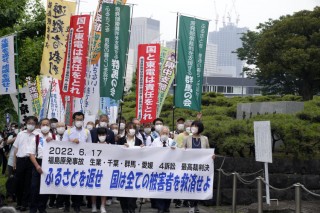Loading
Search
▼ Japan's Top Court Rules Gov't Not Liable For Fukushima Disaster
- Category:Event
Japan's top court on Friday dismissed claims that the government should pay damages in cases involving around 3,700 people whose lives were seriously affected by the 2011 Fukushima nuclear disaster, absolving the state of responsibility for the crisis that led to mass evacuations.
The decision by the Supreme Court's Second Petty Bench was the first for the top court and covered four lawsuits filed in Fukushima, Gunma, Chiba and Ehime prefectures. Around 30 such lawsuits have been filed across Japan by people who had to evacuate from their homes or whose lives were greatly impacted by the earthquake- and tsunami-triggered disaster.
The ruling leaves Tokyo Electric Power Company Holdings Inc (TEPCO), the operator of the crippled Fukushima Daiichi nuclear power plant, solely responsible for slightly over 1.4 billion yen in damages in the four lawsuits. The top court finalized the utility's liability in March for the first time.
The ruling marks a major milestone 11 years after a massive earthquake and ensuing tsunami in Japan's northeastern region triggered the world's worst nuclear accident since the 1986 Chernobyl disaster and will inevitably set a precedent for future cases.
Lower courts were split over the extent of the state's responsibility for the disaster as the regulator of TEPCO. Of the four lawsuits, high courts had found the state responsible except in the Gunma case.
The focal point of the four suits was whether the government and TEPCO were able to foresee the huge tsunami that hit the seaside plant on March 11, 2011, and take preventive measures beforehand, with conflicting claims made by the parties regarding the government's long-term earthquake assessment made public in 2002.
The assessment, made by the government's earthquake research promotion unit, predicted a 20 percent chance of a magnitude-8-level tsunami-triggering earthquake occurring along the Japan Trench in the Pacific Ocean within 30 years, including the area off Fukushima.
Based on the assessment, a subsidiary of the power company had estimated in 2008 that a tsunami of up to 15.7 meters could strike the nuclear power plant.
The plaintiffs argued that the disaster was, therefore, preventable if the government had exercised its regulatory powers to order the company to take preventative measures against flooding based on the long-term assessment.
The government and the company, for their part, claimed that the assessment was not established knowledge, and even if they had foreseen a tsunami higher than the site of the plant and taken measures against it, they could not be held liable as the scale and direction of the actual tsunami differed from estimates.
Of the roughly 30 damages suits seeking compensation from the state and the company over the disaster since 2013 by more than 12,000 people, lower courts have issued rulings in 23.
In 12 cases, courts acknowledged that the government and the utility were negligent in preparing for a tsunami similar to the one that struck the facility. In the other 11, courts ordered only the company to pay damages.
© KYODO
- June 17, 2022
- Comment (0)
- Trackback(0)


